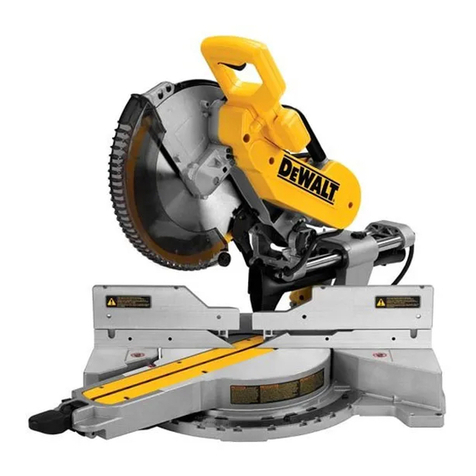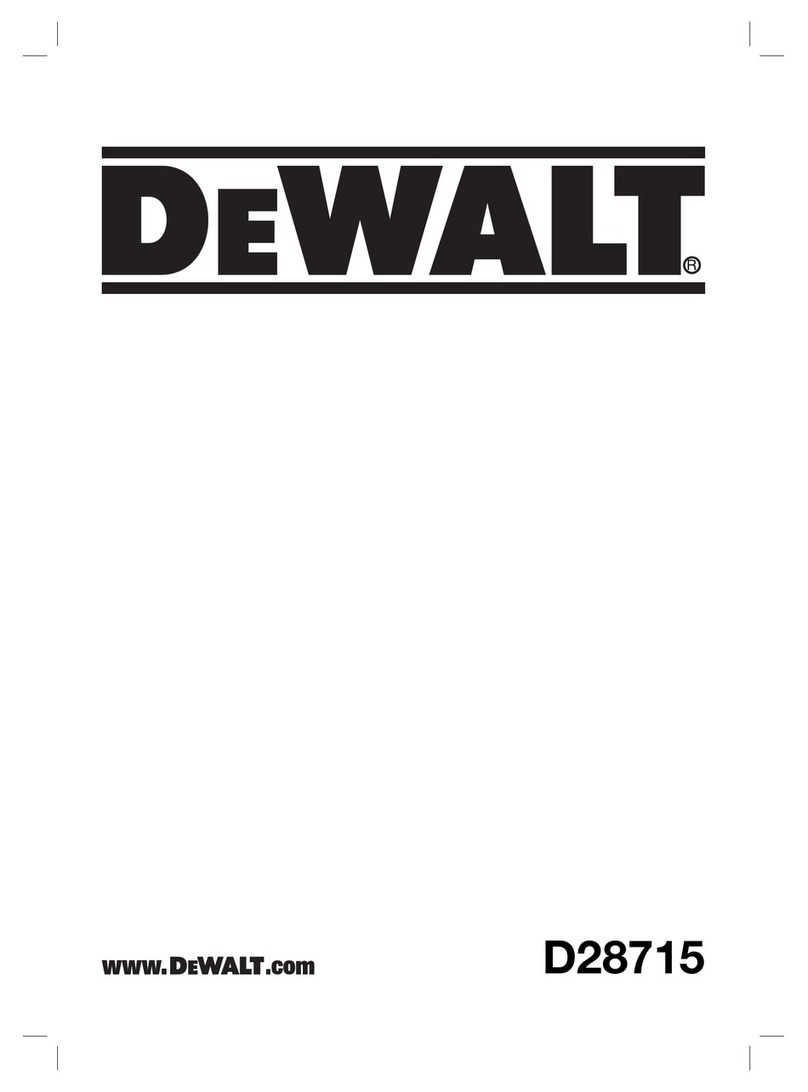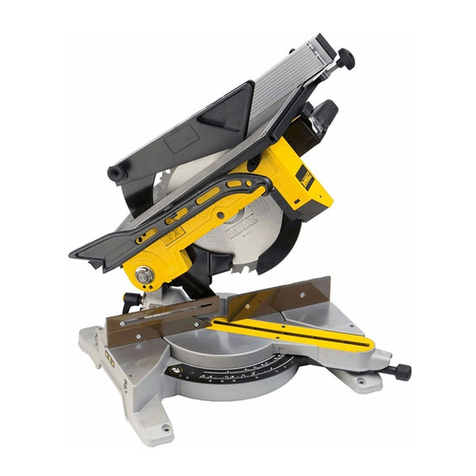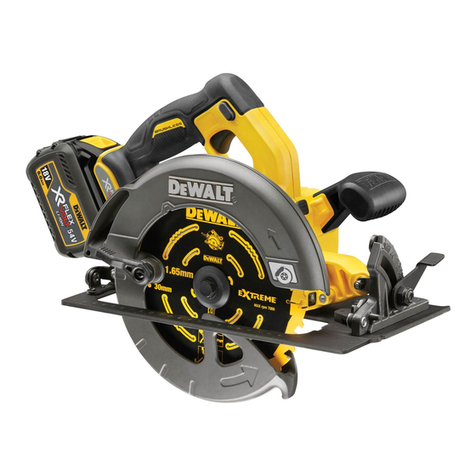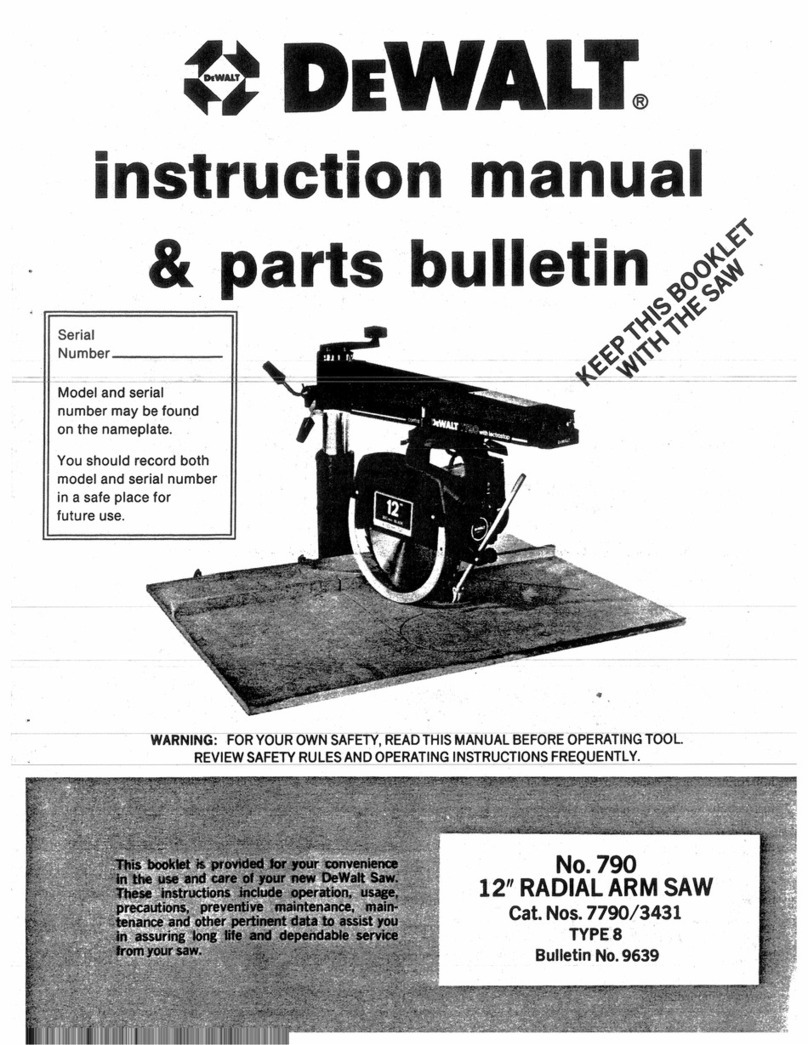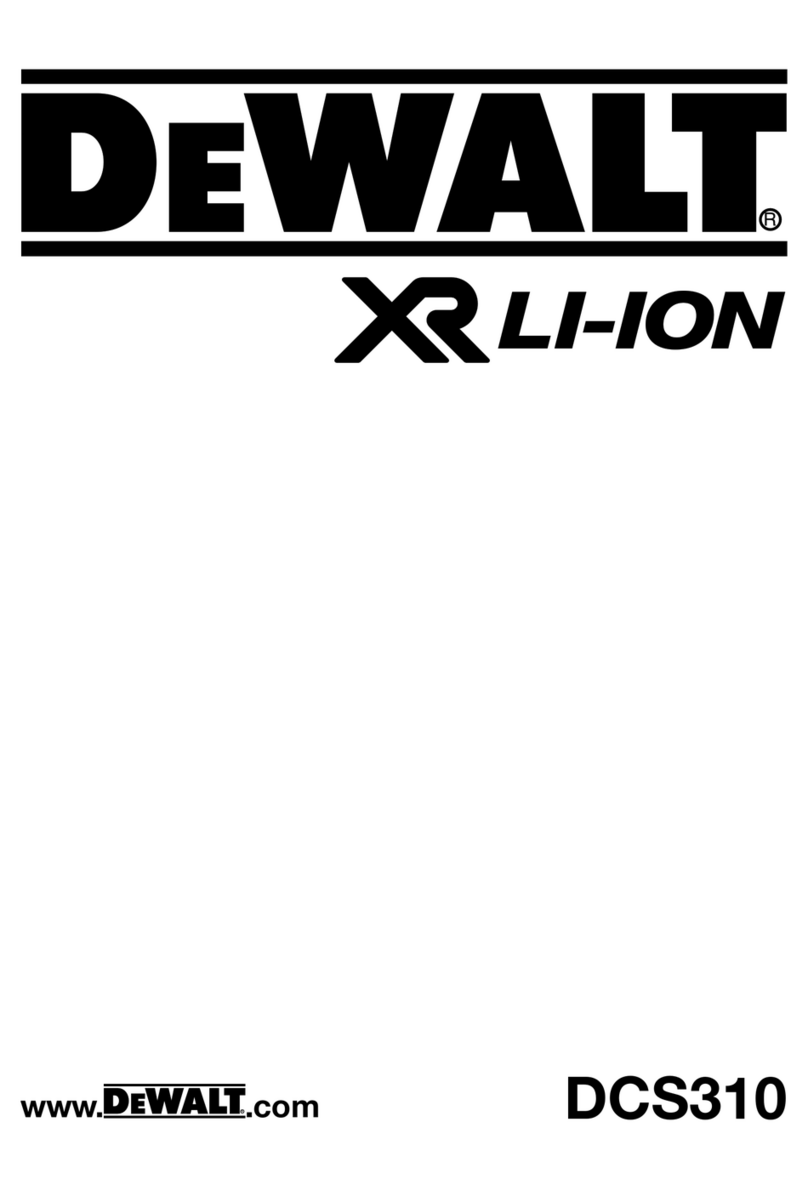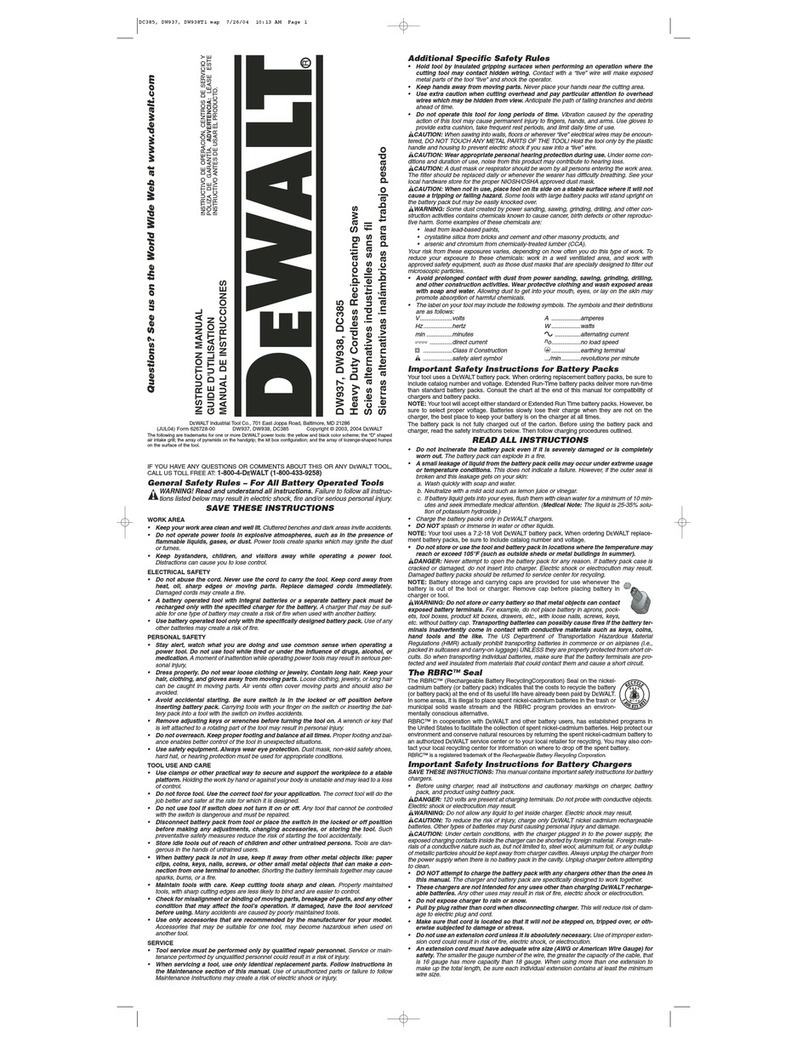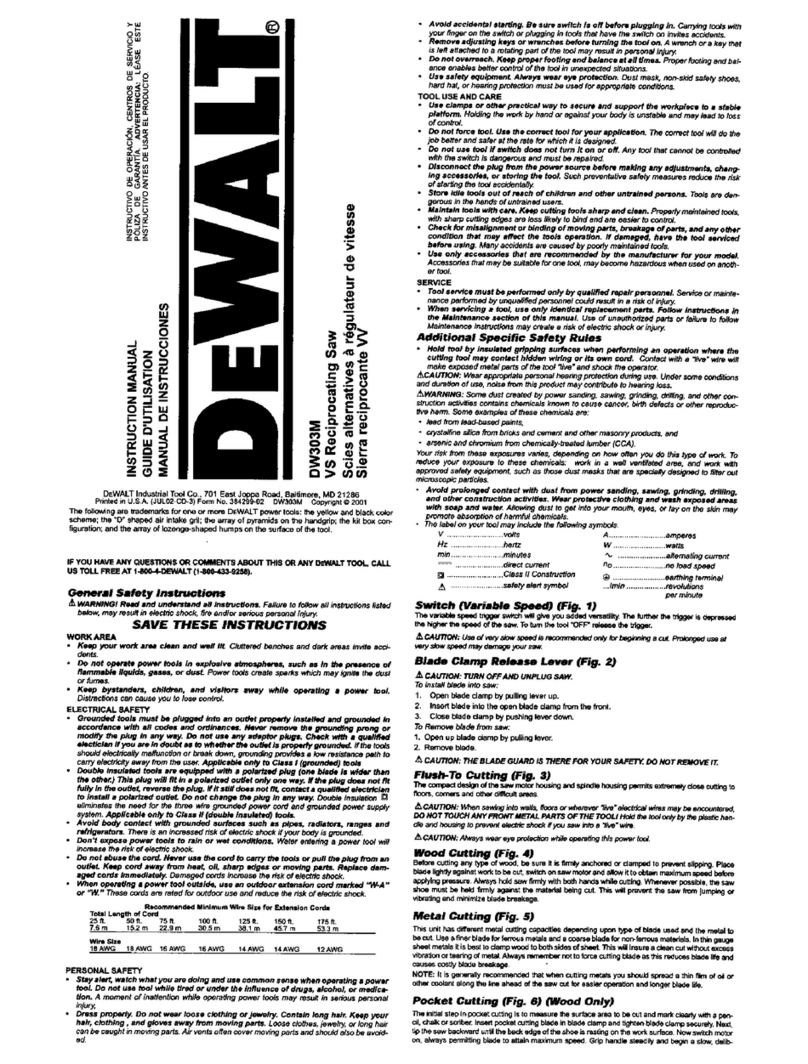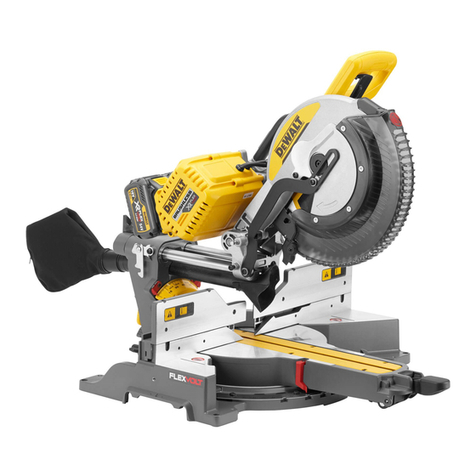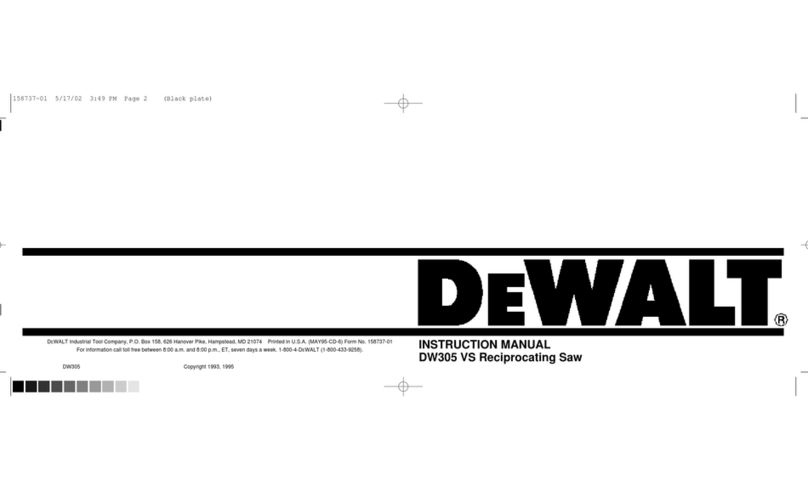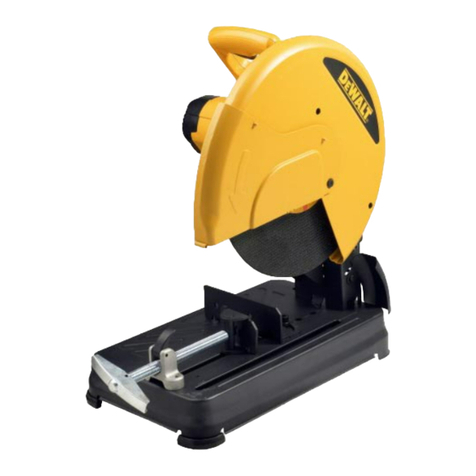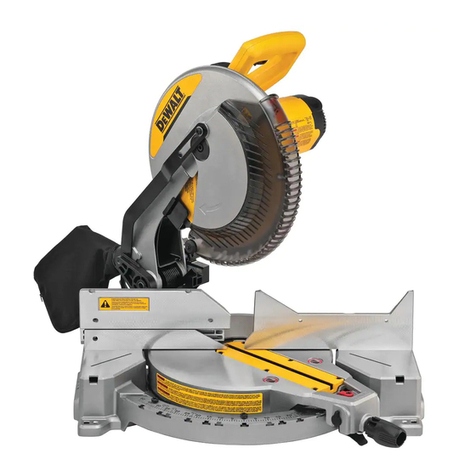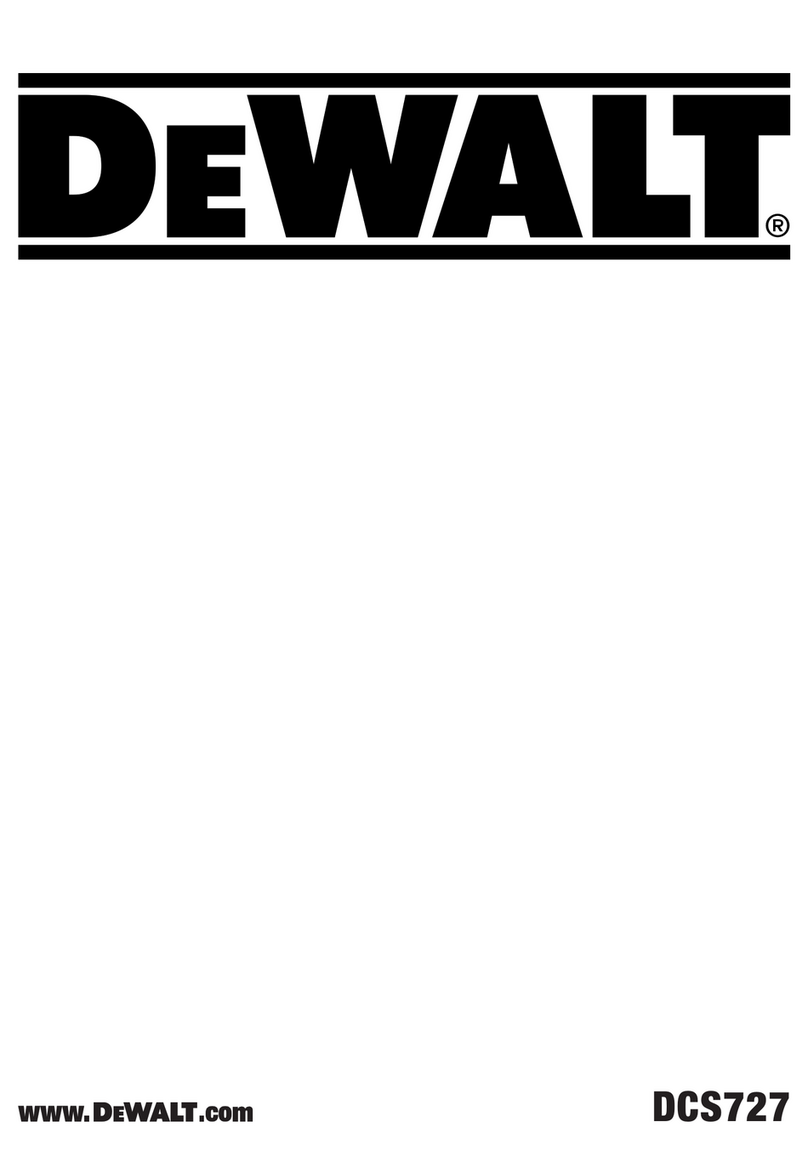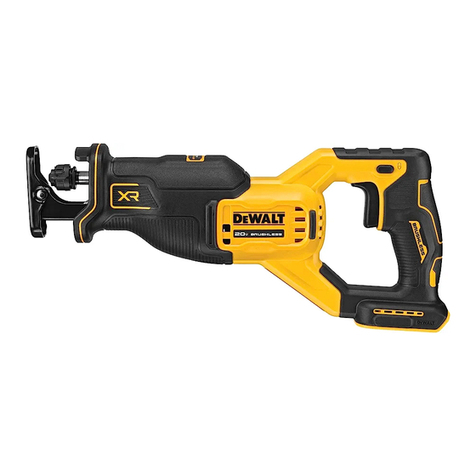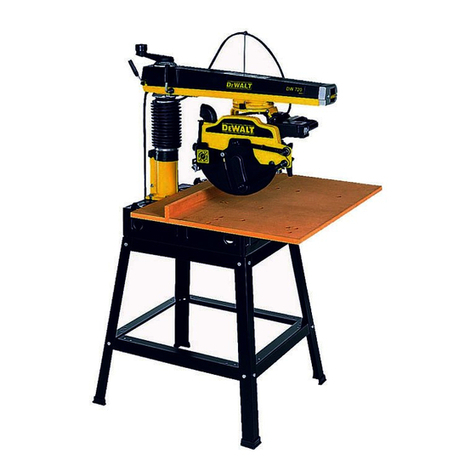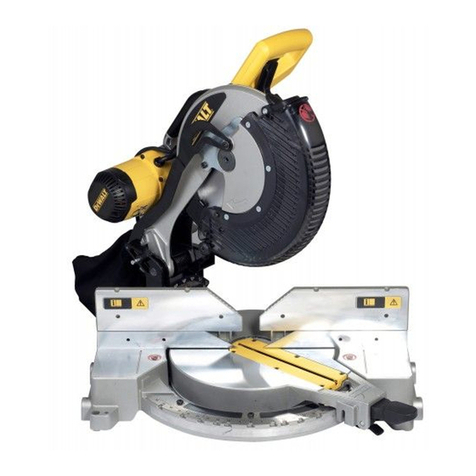• CHECK FOR DAMAGED PARTS. Before further use of the tool, a guard or other part
that is damaged should be carefully checked to determine that it will operate properly and
perform its intended function--check for alignment of moving parts, binding of moving
parts, breakage of parts, mounting and any other conditions that may affect its operation.
A guard or otherpart that is damaged should be properly repaired or replaced. Do not use
tool if switch does not turn it on and off.
•USE RECOMMENDED ACCESSORIES. Use only accessories that are recommended
by the manufacturer for your model Accessories that may be suitable for one tool may be
hazardous when used on another tool Consult the instruction manual for recommended
accessories. The use of improper accessories may cause risk of injury to persons.
•NEVER STAND ON TOOL. Serious injury could occur if the tool is tipped or if the cutting
tool is unintentionally contacted.
•NEVER LEAVE TOOL RUNNING UNATTENDED. TURN POWER OFF. Don't leave
tool until it comes to a complete stop. Serious injury can result.
•DO NOT OPERATE ELECTRIC TOOLS NEAR FLAMMABLE LIQUIDS OR IN
GASEOUS OR EXPLOSIVE ATMOSPHERES. Motors in these tools may spark and
ignite fumes.
•STAY ALERT, WATCH WHAT YOU ARE DOING, AND USE COMMON SENSE. DO
NOT USE THE MACHINE WHEN YOU ARE TIRED OR UNDER THE INFLUENCE
OF DRUGS OR ALCOHOL. A moment of inattention while operating power tools may
result in injury.
Additional Safety Rules For Miter Saws
WARNING: Do not allow familiarity (gained from frequent use ofyour saw) to replace safety
rules.Always remember that a careless fraction of a second is sufficient to inflict severe injury.
•DO NOT OPERATE THIS MACHINE until it is completely assembled and installed
according to the instructions. A machine incorrectly assembled can cause serious injury.
•OBTAIN ADVICE from your supervisor, instructor, or another qualified person if you are
not thoroughly familiar with the operation of this machine. Knowledge is safety.
•STABILITY. Make sure the miter saw is placed on a secure supporting surface and does
not slip or move during use.
•FOLLOW ALL WIRING CODES and recommended electrical connections to prevent
shock or electrocution. Protect electric supply line with at least a 15 ampere time-delay
fuse or a circuit breaker.
•MAKE CERTAIN the blade rotates in the correct direction. The teeth on the blade should
point in the direction of rotation as marked on the saw.
•TIGHTEN ALL CLAMP HANDLES, knobs and levers prior to operation. Loose clamps
can cause parts or the workpiece to be thrown at high speeds.
•BE SURE all blade and blade clamps are clean, recessed sides of blade clamps are
against blade and arbor screw is tightened securely. Loose or improper blade clamping
may result in damage to the saw and possible personal injury.
•ALWAYS USE A SHARP BLADE. Check the blade to see if it runs true and is free from
vibration. A dull or a vibrating blade can cause damage to the machine and/or serious
injury.
•DO NOT OPERATE ON ANYTHING OTHER THAN THE DESIGNATED VOLTAGE for
the saw. Overheating, damage to the tool and personal injury may occur.
•DO NOT WEDGE ANYTHING AGAINST THE FAN to hold the motor shaft. Damage to
tool and possible personal injury may occur.
•DO NOT FORCE CUTTING ACTION. Stalling or partial stalling of motor can cause
damage to the machine or blade and/or serious injury.
•ALLOW THE MOTOR TO COME TO FULL SPEED priorto starting cut. Starting the cut
too soon may cause damage to the machine or blade and/or serious injury.
•NEVER CUT FERROUS METALS (those with any iron or steel content) or masonry.
Either of these can cause the carbide tips to flyoff the blade at high speeds causing serious
injury.
•DO NOTUSEABRASIVE WHEELS. The excessive heat and abrasive particles generated
by them may damage the saw and cause personal injury.
•NEVER HAVE ANY PART OF YOUR BODY IN LINE WITH THE PATH OF THE SAW
BLADE. Personal injury will occur.
•NEVER APPLY BLADE LUBRICANT TO A RUNNING BLADE. Applying lubricant could
cause your hand to move into the blade resulting in serious injury.
•DO NOT place either hand in the blade area when the saw is connected to the power
source. Inadvertent blade activation may result in serious injury.
•DO NOT PERFORM FREEHAND OPERATIONS (workpiece not supported by table and
fence). Hold the work firmly against the fence and table. Freehand operations on a miter
saw could cause the workpiece to be thrown at high speeds, causing serious injury.
•NEVER REACH AROUND OR BEHIND THE SAW BLADE. A blade can cause serious
injury.
•DO NOT REACH UNDERNEATH THE SAW unless it is unplugged and turned off.
Contact with saw blade may cause personal injury.
•SECURE THE MACHINE TO A STABLE SUPPORTING SURFACE. Vibration can
possibly cause the machine to slide, walk, or tip over, causing serious injury.
•USE ONLY CROSSCUT SAW BLADES recommended for miter saws. For best results,
do not use carbide tipped blades with hook angles in excess of 7 degrees. Do not use
blades with deep gullets. These can deflect and contact the guard, and can cause damage
to the machine and/or serious injury.
•USE ONLY BLADES OF THE CORRECT SIZE AND TYPE specified for this tool to
prevent damage to the machine and/or serious injury.
•INSPECT BLADE FOR CRACKS or other damage prior to operation. A cracked or
damaged blade can come apart and pieces can be thrown at high speeds, causing serious
injury. Replace cracked or damaged blades immediately.
•CLEAN THE BLADE AND BLADE CLAMPS prior to operation. Cleaning the blade
and blade clamps allows you to check for any damage to the blade or blade clamps. A
cracked or damaged blade or blade clamp can come apart and pieces can be thrown at
high speeds, causing serious injury.
•DO NOT use lubricants or cleaners (particularly spray or aerosol) in the vicinity of the
plastic guard. The polycarbonate material used in the guard is subject to attack by certain
chemicals.
•ALWAYS USE THE KERF PLATE AND REPLACE THIS PLATE WHEN DAMAGED.
Small chip accumulation under the saw may interfere with the saw blade or may cause
instability of workpiece when cutting.
•USE ONLY BLADE CLAMPS SPECIFIED FOR THIS TOOL to prevent damage to the
machine and/or serious injury.
•CLEAN THE MOTOR AIR SLOTS of chips and sawdust. Clogged motor air slots can
cause the machine to overheat, damaging the machine and possibly causing a short which
could cause serious injury.
•KEEP ARMS, HANDS, AND FINGERS AWAY FROM THE BLADE to prevent severe
cuts. Clamp all workpieces that would cause your hand to be within 6" (152 mm) of the
saw blade.
•NEVER LOCK THE SWITCH IN THE "ON" POSITION. Severe personal injury may
result.
•TURN OFF THE MACHINE and allow the blade to come to a complete stop before
raising the arm and prior to cleaning the blade area, removing debris in the path of the
blade, before servicing or adjusting tool A moving blade can cause serious injury.
